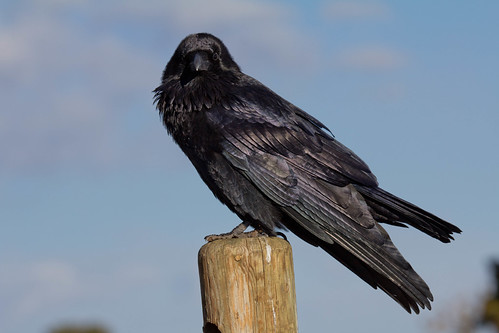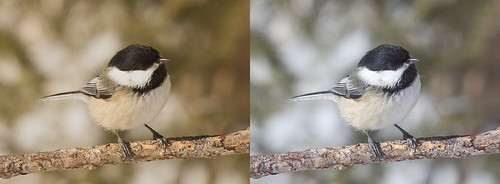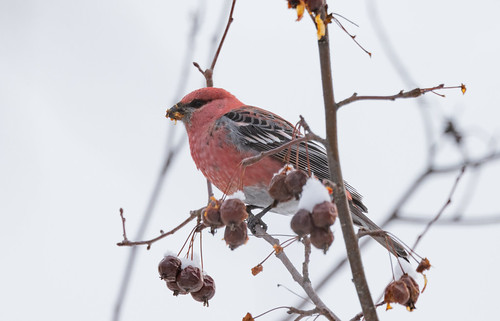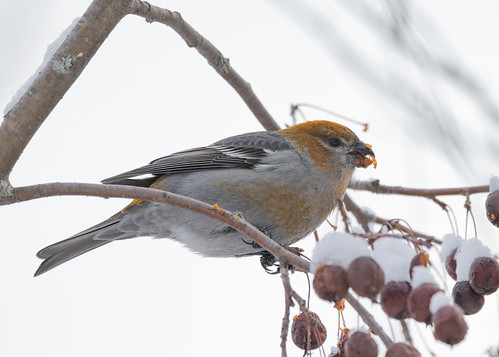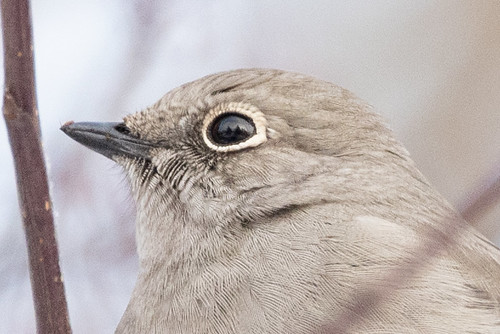The Christmas Bird Count was started on Christmas Day in 1900 by Frank Chapman, who wanted to provide an alternative to “Christmas Side Hunt” competitions. Birdwatching has never been in competition with hunting—indeed, there’s quite a bit of overlap between the two. I know many deer hunters who also participate in the Christmas Bird Count.
I also know lots of birders who have done the exact same bird count routes every year for decades, and many who have done two or more different Christmas Bird Counts every year for decades. Here in Duluth, several birders manage to do the "Big Three": the Duluth, Two Harbors, and Sax-Zim Bog counts, which are always scheduled on different days.
As much as I treasure both tradition and the Christmas Bird Count, I’ve not been nearly so faithful or energetic. I couldn’t go out the first year we were in Duluth, having a brand new baby. I vowed never to miss another one, but various parental duties including two more new babies, my publishers scheduling Christmastime book signings, my job in Ithaca, New York, one nasty bout with the flu, and probably a few more flimsy excuses have kept me from participating in quite a few Duluth Christmas Bird Counts over the years, and I’ve done only a handful of other counts since we left Madison, Wisconsin in 1981.
Yet somehow when I do participate in the Duluth count, it feels ever so homey and traditional. This year, it was held Saturday, December 17. We had to deal with deep snows and wild winds, but the temperature reached a balmy 30º.
My friend Janet Riegle has been doing upper Lakeside with me for quite a few years now, and being much steadier and more responsible than me, she’s served as our area’s count leader since I got my job at Cornell in 2008. When I’m around to participate, we always meet between 7:15 and 7:30 at my house, so while we’re getting organized, we can watch for birds at my feeders. Then we walk around the blocks above Peabody Street for 2 ½ hours or so, dividing them so our team can get the area between Colorado and Glenwood Streets completely covered before 10 am. We finish up the rest of upper Lakeside by lunch. Then those of us able to bird a full day head to our afternoon spot between McQuade and Lakewood Roads. We mostly drive that section, which is larger geographically while producing way fewer birds than we see in Duluth proper.
This year, we split up our morning area so I could cover the southeastern quarter with Susan Relf and, for a while, Clint Moen while Janet Riegle and John Kelsey covered the southwestern quarter. A group of ravens must be roosting somewhere in or near Lester Park, because 22 flew over from that direction heading southwest in a loose flock a few minutes after we started out. During that first half of the morning, ravens outnumbered crows, but the littler corvids sure caught up. By day’s end, Janet and I had tallied 40 ravens and 53 crows; for Duluth’s entire count circle, a full 1,305 crows were counted, breaking the previous record, set in 2001, by more than 350. The total raven count for the day was 150—about an order of magnitude lower than the crow count.
Mallards were very well represented. In the morning, Susan and I counted 20 in a single flock flying north, but then started seeing lots of smaller groups heading both south and north. We couldn’t be sure if they were new individuals or parts of the original large flock, so we didn’t add them. Our day's total was 36 while the full Duluth count was 1,171 Mallards. That was the most since 2017 but well shy of the record 1,862 counted in 2001.
Now off on a tangent: Three years ago, I got cataract surgery. The first eye was done a week and a half before Christmas, and the second two weeks later, which means the vision in my two eyes on that year’s Christmas Bird Count was extremely marginal. I set the diopter adjustment on my binoculars so when looking through them, both eyes were in focus, but looking for birds before I pulled up the binoculars was disorienting and even dizzying. And even through my eyes focused together through the binoculars, the image through the eye with the new lens was much much brighter than through the other eye, which was also disorienting.
A few days' discomfort, even though one of them was Christmas Bird Count Day, was totally worth it. Since the second eye was done, my vision has been not just very good—it’s the best it’s been in my life. I need glasses for most close-range vision, but don’t need them at all while birding. This year I did my morning count with Susan Relf, the very ophthalmologist who did that cataract surgery.
This year's count was lackluster, in large part due to weather. Saturday’s total for the Duluth count circle was a below-average 53 species, with six more species, including the second Eastern Screech-Owl ever found on the count, at least seen during Count Week. Janet and my total of 25 species seen in our areas was about average for us, though individual bird numbers were low.
After covering Lakeside below Glenwood the first half of the morning, we met up at my house at 10:00. Russ set out cookies and hot spiced cranberry/apple juice, and this year John brought a batch of chocolate chip cookies, too. Despite the fierce wind, the temperature was climbing up through the 20s, so we didn’t need to warm up much before we set out to cover upper Lakeside until lunch. Janet and John found the Townsend’s Solitaire she’s been keeping track of and got great photos. And I was thrilled when a Northern Flicker flew over my head, certain that I’d seen the rarest bird of the day.
At lunch, Janet and I did our afternoon area east of town between Lakewood and McQuade Roads on our own. We didn’t see much but did come upon a lovely little flock of Pine Grosbeaks close enough to give us some lovely photos.
We finished up in time for Janet to bring me to the spot where she’d had the Townsend’s Solitaire in the morning, and the sweet little bird was close enough, and low enough, to give me my best photos ever.
Winter solitaire appearances in Duluth are growing more numerous. We’ve had at least one on the Christmas Bird Count or during Count Week in 7 of the last 10 years, and since 1980, we’ve totaled 2 on 5 different years. I was hoping we’d break that record, because Janet’s been seeing hers consistently for weeks even as Susan, living 2 ½ miles from that spot, had two individuals coming together to her crabapples several times, including just three days before Count Week began, and a few days after it ended. Janet’s bird was the only one seen on the day or week of this year's count, living up to the name Solitaire.
My flicker wasn’t as notable as I’d hoped—two other groups reported one, and this year’s total of 3 wasn’t even a record—4 flickers were counted on Duluth’s Christmas Bird Count in 1967. And at least one flicker has been reported on 18 counts since 1948. Those little details didn’t make my own sighting less exciting for me.
The only new bird seen on this year’s count wasn’t a species. The male Oregon Junco is a western subspecies of the Dark-eyed Junco. At the start of Count Week, at the same feeder, there was a “Cassiar Junco”—that one wasn’t a subspecies but a hybrid of the Slate-colored and Oregon Junco subspecies.
We broke three records. As I already mentioned, the crow count was the highest ever. The 394 goldfinches seen broke the previous record, set in 2013, by almost 100. And the 29 Red-bellied Woodpeckers not only broke the record of 23 set in 2018—this also marks the fourth time in the past 5 years that the Red-bellied count exceeded 20.
Also notable were the 117 robins, the most since our high count of 259 set in 2009. The 137 Evening Grosbeaks were the most counted since 2005. And this year's 10 Snow Buntings were the count's first since 2016. Also notable, but sad, we had only 7 Ruffed Grouse, possibly at least in part due to the heavy new snow. White-breasted Nuthatches and Northern Cardinals were both found in much lower numbers than recent counts. And this was the first count since 2000 when not a single crossbill—neither White-winged nor Red—was found at all.
A single year’s count doesn’t mean a whole lot in terms of increasing or decreasing populations, because each year’s weather makes a huge difference. This year’s numbers are entered into the database, more pieces of a gigantic puzzle that helps us see patterns, thanks to the many volunteer counters and Duluth's wonderful count compiler, Clinton Dexter-Nienhaus.
Here's this year's totals:
- Canada Goose- 6
- Mallard- 1171
- American Black Duck- 20
- Common Goldeneye- 62
- Common Merganser- 1
- Red-breasted Merganser- 6
- White-winged Scoter- 1
- Wild Turkey- 2
- Ruffed Grouse- 7
- Rock Pigeon- 1025
- Mourning Dove- 13
- Ring-billed Gull- 2
- Herring Gull- 516
- Iceland Gull- 5 (All Thayer's Gulls)
- Glaucous Gull- 2
- Lesser Black-backed Gull- 1 (first cycle continuing in our area)
- Great Black-backed Gull- COUNT WEEK
- Golden Eagle- 2
- Sharp-shinned Hawk- COUNT WEEK
- Northern Goshawk- 3
- Bald Eagle- 44
- Red-tailed Hawk- COUNT WEEK
- Great Horned Owl- COUNT WEEK
- Snowy Owl- COUNT WEEK
- Barred Owl- 1
- Eastern Screech Owl- COUNT WEEK
- Red-bellied Woodpecker- 29
- Downy Woodpecker- 85
- Hairy Woodpecker- 75
- Pileated Woodpecker- 32
- Northern Flicker- 3
- Belted Kingfisher- 1
- Merlin- 2
- Peregrine Falcon- 2
- Northern Shrike- 7
- Blue Jay- 89
- American Crow- 1305
- Common Raven- 150
- Black-capped Chickadee- 1794
- Red-breasted Nuthatch- 99
- White-breasted Nuthatch- 87
- Townsend's Solitaire- 1
- American Robin- 117
- European Starling- 1309
- Bohemian Waxwing- 1147
- Cedar Waxwing- 140
- Waxwing sp.- 22
- Evening Grosbeak- 137
- Pine Grosbeak- 89
- House Finch- 89
- Purple Finch- 2
- Common Redpoll- 496
- Pine Siskin- 2
- American Goldfinch- 394
- Finch sp.- 12
- Snow Bunting- 10
- Dark-eyed Junco- 33 (2 oregonus, Count Week cismontanus)
- White-throated Sparrow- 2
- American Tree Sparrow- 1
- Northern Cardinal- 8
- House Sparrow- 87

